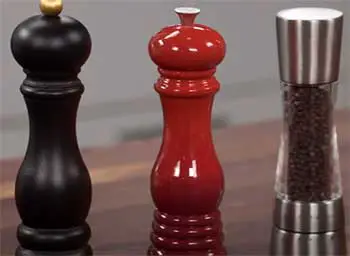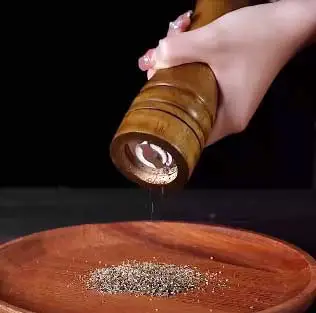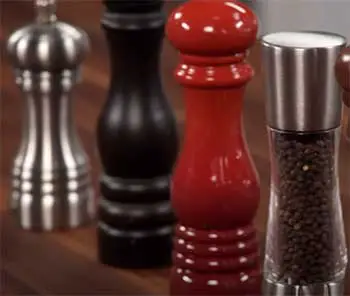Pepper is one of the most commonly used spices in kitchens around the world. Whether you’re seasoning a steak, adding flavor to vegetables, or preparing a marinade or rub, freshly ground black pepper can make all the difference.
But should you use a pepper mill or a pepper grinder? Is there really a difference, other than the name?
In short – yes, there are some important distinctions between pepper mills and pepper grinders that you should understand before choosing one for your kitchen.
Here’s a quick overview of how these two types of pepper grinding tools compare:
| Attribute | Pepper Mill | Pepper Grinder |
| Grinding Mechanism | Usually contains steel or ceramic grinding mechanism | Typically uses carbon steel or stainless steel blades |
| Design | Tall, elegant, designed for tableside use | Compact for easy handheld grinding |
| Grind Size | Often offers range of adjustable coarseness settings | Usually produces very fine powder only |
| Best Use Case | Tableside grinding over salads, pasta, etc. | Grinding peppercorns quickly into shakers/bowls |
This table shows some of the key differences. Pepper mills are manually operated and designed for elegance and adjustable grinds, while pepper grinders prioritize ease of use and consistency over customization.
Below we’ll explore each type in more detail, look at the pros and cons, typical use cases, and important features to consider. There’s also a FAQ section at the end to answer some common questions people have about pepper mills versus grinders.
Pepper Mill Overview

Pepper mills, sometimes also called pepper grinders, are specifically designed for grinding whole peppercorns at the tableside or during food preparation.
They typically feature a long, slender body and vertical grinding mechanism that allows you to mill pepper with a twisting motion while holding the mill upright over a dish or food you want to season.
Pepper mills offer a sense of elegance, class and ceremony to dinnertimes and food preparation. Their aesthetic design and functional purpose are both geared toward tableside presentation.
Plus, pepper ground freshly at the table has an unmatched aroma and flavor.
Here are some of the typical features and defining qualities of a good pepper mill:
- Adjustable Coarseness Settings – High-end pepper mills allow you to choose just how fine or coarse you want the ground pepper to be. Look for mills with at least 6 settings to give you versatility.
- Large Hopper – A transparent hopper shows off the whole peppercorns while also allowing you to monitor remaining levels. Larger hopper capacities reduce the need for frequent refilling.
- Easy Cranking – Well-constructed mills don’t require immense physical effort to operate. If it’s overly difficult to grind, chances are you won’t use it much.
- Ceramic or Steel Grinding Mechanism – Ceramic and stainless steel provide durability, strength, ease of use and spice-neutral grinding without corrosion.
- Acrylic/Wood Construction – The choice between acrylic glass or varnished wood comes down mainly to visual appeal and longevity.
By keeping these attributes in mind as you shop, you’ll be able to select a high-quality pepper mill that makes an elegant statement on your dining table while also delivering excellent grind performance.
Pepper Grinder Overview

While a pepper mill aims for classy, ceremonial appeal, pepper grinders prioritize speed, simplicity and utility.
Pepper grinders are compact, handheld devices designed specifically for quickly grinding peppercorns down into a fine powder.
Instead of winding a knob while holding the mill upright, most pepper grinders utilize either a squeeze grip, twist motion or pump action to rapidly grind peppercorns using stainless steel blades inside.
This powdered pepper is ideal for filling shakers or adding to rubs and marinades.
Here are the key qualities to evaluate with pepper grinders:
- Carbon or Stainless Steel Blades – Durable steel blades are up to the task of grinding whole peppercorns down into fine powder with efficiency.
- Self-Cleaning – Look for grinders designed in a way that allows excess powder to clear out instead of clogging up the mechanisms.
- Ergonomic Design – Since most pepper grinders are operated with a simple hand squeeze, the handles should provide non-slip grip and comfortable squeezing.
- Transparent Chamber – Just like with pepper mills, transparent chambers make it easy to monitor remaining peppercorn levels so you know when it’s time to refill.
- Easy to Disassemble – You’ll occasionally need to fully disassemble certain grinders for thorough cleaning or maintenance. Quick breakdown with minimal components aids this process.
Pepper grinders provide fast, fuss-free pepper grinding virtually anywhere around your kitchen. With the right model, freshening up existing ground pepper or filling extra shakers takes only seconds.
Pepper Mill Pros and Cons
Pros

- Elegant, stylish appearance looks great on dining tables
- Provides true customization – grind pepper to preferred coarseness
- Ceramic or steel grinding mechanism delivers pure and neutral pepper flavor
- Freshly cracked pepper has maximum aroma and flavor over pre-ground
- Allows grinding directly onto foods for convenience and less mess
- Tall design lets gravity aid grinding efficiency
- Large capacity removable hoppers reduce refill frequency
Cons
- Manual twisting grinding can be slow and physically demanding
- Spout placement/angle doesn’t always hit food accurately
- Top heavy design increases chance of tipping over if bumped
- More prone to clogging compared to electric grinders
- Generally too tall and cumbersome for portable use
- Limited color and style options on most models
- Cost more than basic compact pepper grinders
Pepper Grinder Pros and Cons
Pros
- Extremely fast and easy spice grinding with squeeze/twist motion
- Compact size takes up little storage space
- Portable for camping trips, picnic baskets, or even purse/pocket
- Durable stainless steel blades make quick work of hard peppercorns
- Self-cleaning models resist buildup of oil and ground pepper
- Generates fine, powdery pepper ideal for shakers and rubs
- Often comes in fun colors to match your kitchen décor
- Very affordable even for high end models
Cons
- Provides only very finely powdered pepper – no adjustability
- Oblong shape and small spout increase mess during grinding
- No transparency to monitor remaining peppercorn supply
- Plastic housing feels flimsy and cheap on some budget models
- Powder-only grind style limits suitability for finishing dishes
- No presentation value for tableside grinding
- Short life expectancy – often last 1-2 years before failing
Also Read: Problems With Cuisinart Salt And Pepper Mill.
Ideal Use Cases
So when should you use a pepper mill versus a pepper grinder? Here are the best applications for each:
Pepper Mills
- Adding freshly cracked pepper to salads, pasta, meats & more at the dinner table
- Quickly grinding pepper as a finishing touch/final flavor boost while cooking
- Allowing guests to grind pepper to their preferred size during meals
- Impressing dinner party guests with elegant table presentation
Pepper Grinders
- Rapidly filling multiple small bowls of powdered pepper for weeknight meal prepping
- Refilling pepper shakers or grinders that have run empty
- Grinding peppercorns down before adding to rubs, marinades, dressings and dips
- Portable pepper supply for campers, trail mix additions, picnic baskets & lunch bags
As you can see, pepper mills are optimized for adjustable tableside use and direct seasoning of complete dishes. Pepper grinders provide fast batch powder production.
Important Features to Compare
Here are some of the most important performance factors and features to stack up when deciding between specific pepper mill and pepper grinder models:
- Grinding Mechanism – Pepper mills can finely customize grind size thanks to their grinding mechanism (usually ceramic or steel burrs similar to coffee grinders). Pepper grinders simply powder everything through stainless steel blades.
- Ease of Use – Grinding effort and handling comfort affects the enjoyment of any manual grinder. Pay attention to crank smoothness for mills and handle ergonomics for grinders.
- Appearance – Do you want an elegant showpiece for your table or just a workhorse grinding tool for your spice cabinet? Pepper mill styles and material choices cater to the former.
- Capacity – Larger hoppers reduce the hassle of frequent refilling. But bigger mills lose portability. Decide what matters most – size or mobility.
- Grind Speed – There’s no competition here; grinders pulverize peppercorns significantly faster thanks to their squeeze handle leverage and stainless steel blades. Mills provide slow, methodical grinding.
- Durability – Examine manufacturer workmanship and materials used. Acrylic pepper mills feel cheaper but hold up surprisingly well. Good stainless steel grinders last practically forever.
- Price – You’ll have to pay a premium for attractive wood and acrylic pepper mills with advanced grinding mechanisms. Pepper grinders cost very little even for quality models.
By weighing your needs and preferences across categories like these, you can hone in the perfect pepper dispenser for your kitchen.
Pepper Mill and Grinder FAQs
Here are answers to some of the most frequently asked questions about differences between pepper mills versus pepper grinders:
Pepper mills are specifically designed for tableside use, adjustable grinding and elegant aesthetics. Pepper grinders offer simple, handheld operation focused on rapidly producing fine pepper powder.
Yes – technically pepper mills function as grinders too. So you can certainly use them as fast handheld grinders. But their tall, narrow shapes don’t lend themselves well to this task.
Pepper mills carry a higher price tag but also provide better performance, classy visual appeal for dinner tables, and fresher pepper flavor than pre-ground. So they’re worth it for many households.
Not exactly. Spice grinders are made specifically for dry spices like cinnamon sticks and whole nutmeg. Pepper grinders contain stronger stainless steel blades optimized for grinding hard peppercorns into powder.
Closing Remarks
So in the pepper mill versus pepper grinder debate, is one better than the other? Well, the answer depends entirely on your intended uses and needs around the kitchen.
Pepper mills offer adjustable coarseness, tableside presentation flair, large capacities and ceramic/steel grinding precision. But they lack speed, portability and fine powder versatility compared to compact stainless steel pepper grinders.
If you want ceremony, customization and elegance – go for a pepper mill. In search of affordability, durability and quick powder production? Choose a standalone pepper grinder.
For ultimate flexibility, many cooks actually utilize both mills AND grinders – relying on the former for finishing dishes and meal presentation and the latter for rapidly refilling peppermills and spice containers. This dual approach gives you the ideal tool for any pepper grinding job.
So analyze your own habits, cuisine and priorities to decide if a sophisticated peppermill, a rugged grinder or perhaps both make sense for your kitchen!
